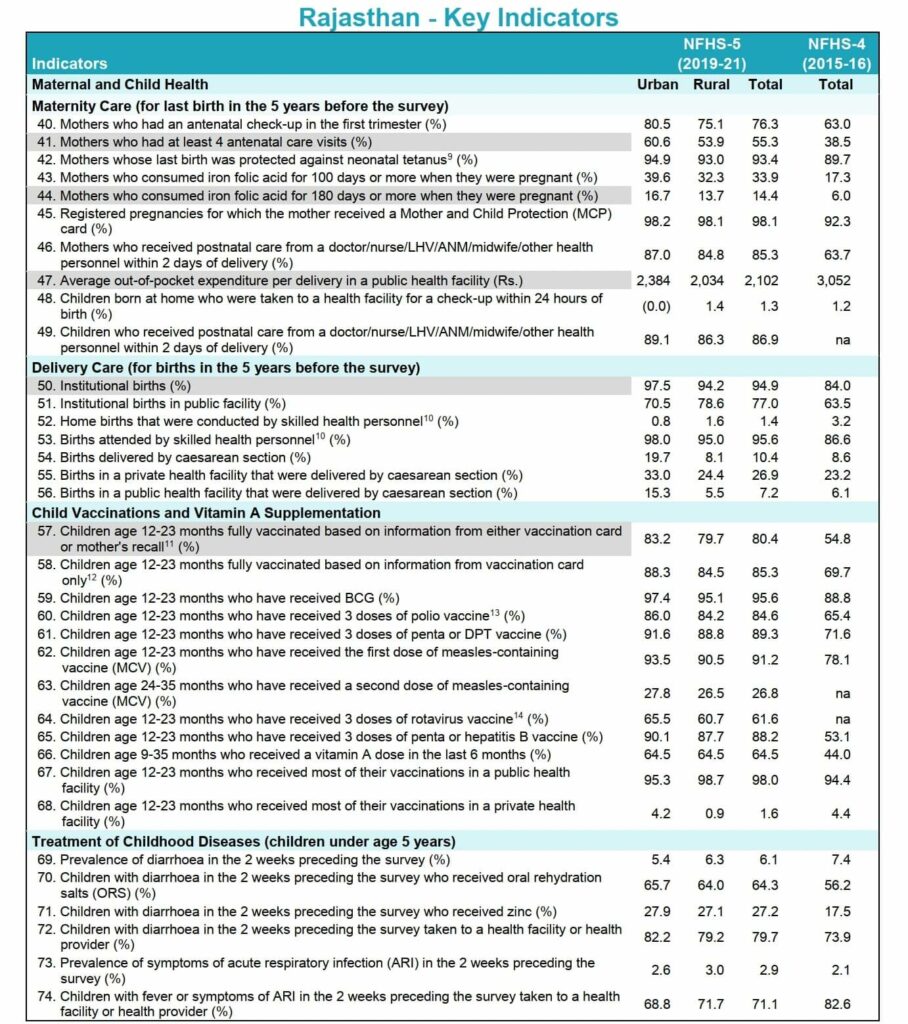The National Family Health Survey 2019-21 (NFHS-5), the fifth in the NFHS series, provides information on population, health and nutrition for India and each State / Union territory. Like NFHS-4, NFHS-5 also provides district-level estimates for many important indicators.
NFHS-5 includes some new topics, such as preschool education, disability, access to a toilet facility, death registration, bathing practices during menstruation, and methods and reasons for abortion.
As in the earlier rounds, the Ministry of Health and Family Welfare, Government of India, designated the International Institute for Population Sciences, Mumbai, as the nodal agency to conduct NFHS-5. The main objective of each successive round of the NFHS has been to provide high-quality data on health and family welfare and emerging issues in this area. NFHS-5 data will be useful in setting benchmarks and examining the progress the health sector has made over time.
The NFHS-5 Rajasthan State Fact Sheet provides information on key indicators and trends for Rajasthan. Due to the Covid-19 situation and the imposition of lockdown, NFHS-5 fieldwork in phase 2 States/UTs was conducted in two parts. NFHS5 fieldwork for Rajasthan was conducted from 2nd January 2020 to 21st March 2020 prior to the lockdown and from 10th December 2020 to 1st March 2021 post lockdown by Indian Institute of Health Management Research (IIHMR). Information was gathered from 31,817 households, 42,990 women, and 6,353 men.
Key Observations from NFHS-5 Rajasthan Fact Sheet:
- Child Marriages: As compared to NFHS-4, the percentage of women between 20 to 24 years, who were married before turning 18, came down to 25.4% which is a decrease of 10%. This decrease was also visible in men between 25 to 29 years, who were married before turning 21 and in 2020-21, 28.2% of men fell in this category as compared to 35.7% in NFHS-4.
- Infant mortality rate (IMR) in Rajasthan has taken a dip from 41 per 1,000 live births (NFHS-4) to 31.3 per 1,000 live births. However, according to NFHS -5, there is a vast difference between IMR in rural areas and in the urban areas. In rural areas, IMR is 32.2 deaths per 1,000 live births. In urban areas of the state, it is 22.2 deaths per 1,000 live births.
- Under-5 mortality rate (U5MR) has also witnessed a dip of 13 points in the state, from 50.7 per 1,000 live births (NFHS-4) to 37.6 per 1,000 live births.
- The Total Fertility Rate (TFR) — average number of children born to a woman in her lifetime — has reduced from 2.2 to 2.0 in the state. The replacement level TFR, at which a population exactly replaces itself from one generation to the next, is estimated to be 2.1. The figures are indicating that the state is on the way of achieving population stabilisation.
- The adolescent fertility rate for women (15-19 years) has reduced from 46 to 31. It is 34 in rural areas, while it is 17 in urban areas.
- The sex ratio of the total population (females per 1,000 males) has increased from 991 to 1,020, shows NFHS-5 (2019-21), when comparing it with NFHS-4 (2015-16). Among adolescent population, the fertility rate has also taken a significant dip.
- Besides, sex ratio at birth has also increased from 919 to 929, which shows that for every 1,000 males born, 929 girl childs were born from 2019 to 2021.
NFHS-5 Rajasthan Fact Sheet


